You’ve probably heard whispers about moringa being the next big superfood, but you’re not sure what all the fuss is about. This powerful green powder has been making waves in health circles, and for good reason – moringa benefits for beginners include everything from boosting energy to supporting your immune system.
This guide is designed specifically for newcomers who want to understand what is moringa superfood and how it can fit into your daily life without overwhelming you with complicated information. You don’t need a nutrition degree to get started with this incredible plant.
We’ll walk you through the basics of what moringa actually is and why health enthusiasts can’t stop talking about it. You’ll also discover the key differences between moringa powder vs capsules, plus practical tips on how to use moringa daily without turning your routine upside down. Finally, we’ll cover the essential moringa side effects dosage information you need to stay safe while exploring this new addition to your wellness toolkit.
Understanding What Moringa Is and Why It Matters
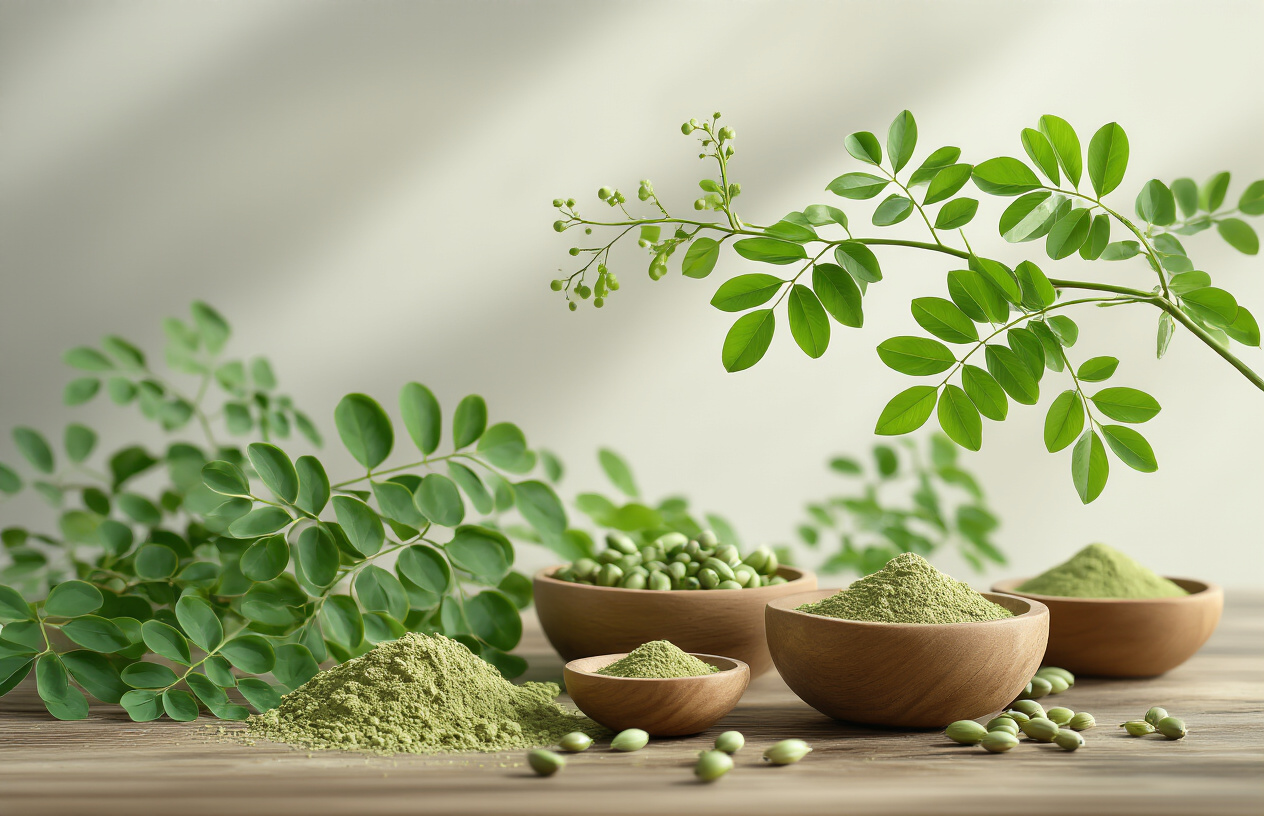
The Complete Nutritional Profile That Makes Moringa a Superfood
When you look at moringa’s nutritional breakdown, you’ll understand why experts call it the “miracle tree.” Your daily serving of moringa leaf powder delivers an impressive array of nutrients that can transform your wellness routine. Each gram contains seven times more vitamin C than oranges, four times more calcium than milk, and three times more potassium than bananas.
The moringa superfood contains all nine essential amino acids your body can’t produce on its own, making it a complete protein source – rare among plant foods. You’ll also get substantial amounts of vitamin A, iron, magnesium, and antioxidants like quercetin and chlorogenic acid. These compounds work together to support your immune system, bone health, and energy levels.
What makes moringa particularly valuable for beginners is its bioavailability – your body can easily absorb and use these nutrients. The moringa nutrition guide shows that just two teaspoons of powder provide significant percentages of your daily requirements for multiple vitamins and minerals.
Scientific Evidence Behind Moringa’s Health Claims
Research backing moringa benefits for beginners continues to grow, with over 1,300 studies examining its therapeutic properties. You can trust that the health claims aren’t just marketing hype – peer-reviewed studies validate many of moringa’s traditional uses.
Clinical trials show moringa can help regulate blood sugar levels, with participants experiencing significant improvements in glucose control after regular consumption. Your cardiovascular health may benefit too, as studies demonstrate moringa’s ability to reduce cholesterol levels and support heart function.
Anti-inflammatory research reveals moringa’s compounds can reduce inflammatory markers in your body, potentially helping with joint pain and chronic inflammation. Studies on cognitive function suggest regular moringa use might support brain health and memory.
The antioxidant research is particularly compelling – moringa ranks higher than many superfoods in ORAC (Oxygen Radical Absorbance Capacity) testing, meaning it’s exceptionally good at neutralizing free radicals that damage your cells.
How Moringa Compares to Other Popular Superfoods
When you compare moringa to other superfoods, the differences become clear. Here’s how moringa stacks up against popular alternatives:
| Nutrient | Moringa | Spirulina | Kale | Spinach |
|---|---|---|---|---|
| Protein (per 100g) | 27g | 57g | 4.3g | 2.9g |
| Iron | 28mg | 28mg | 1.5mg | 2.7mg |
| Calcium | 2003mg | 120mg | 150mg | 99mg |
| Vitamin C | 513mg | 10mg | 120mg | 28mg |
Your choice between superfoods depends on your specific needs. While spirulina beats moringa in protein content, moringa wins in vitamin C and calcium. Compared to leafy greens like kale and spinach, moringa offers concentrated nutrition that’s easier to consume daily.
Cost-wise, moringa often provides better value than exotic superfoods like açai or goji berries. You get more nutritional bang for your buck, especially when buying organic moringa products in bulk.
The taste factor matters too – moringa has a mild, earthy flavor that’s more palatable than the strong taste of spirulina or chlorella. This makes it easier for you to stick with your daily routine, whether you choose moringa powder vs capsules or other forms.
Different Forms of Moringa and Their Unique Benefits
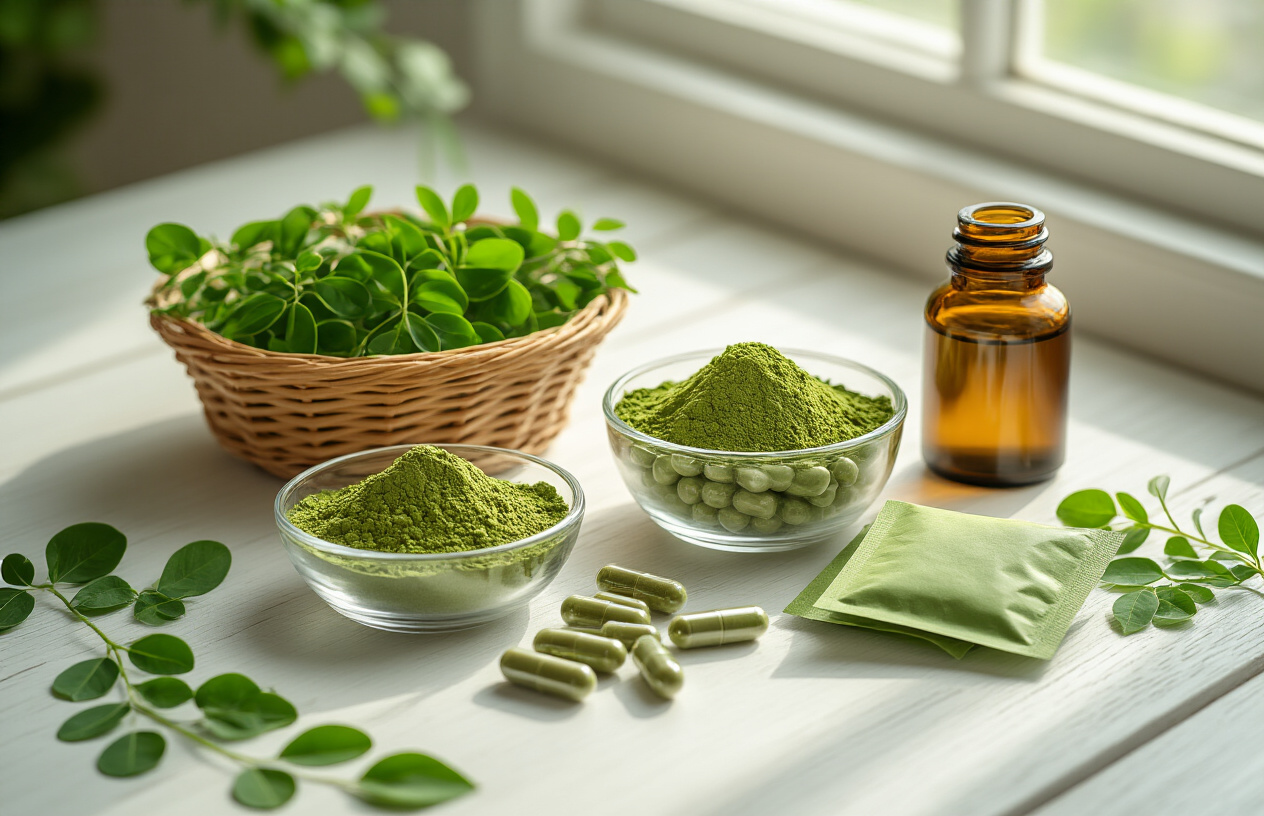
Fresh Moringa Leaves: Maximum Potency and Preparation Tips
Fresh moringa leaves pack the highest nutritional punch compared to processed forms. When you harvest or purchase fresh leaves, you’re getting the complete spectrum of vitamins, minerals, and antioxidants in their most bioavailable state. The vitamin C content in fresh leaves can be up to 7 times higher than in oranges, while the calcium levels rival those found in milk.
You’ll find fresh moringa leaves have a slightly peppery, spinach-like taste that works well in various dishes. To prepare them, wash the leaves thoroughly and remove them from the stems. You can eat them raw in salads, blend them into smoothies, or cook them like any leafy green vegetable. Steam them lightly for 2-3 minutes to preserve maximum nutrients, or sauté with garlic and olive oil for a simple side dish.
Storage is crucial for maintaining potency. Keep fresh leaves in your refrigerator for up to a week, wrapped in damp paper towels inside a plastic bag. For longer storage, you can freeze clean, dry leaves in ice cube trays with water, creating convenient portions for future use in smoothies or soups.
Moringa Powder vs Capsules: Convenience and Versatility for Daily Use
Moringa leaf powder benefits make it the most popular form for beginners exploring this superfood. When fresh leaves are dried at low temperatures and ground, you get a concentrated powder that retains most nutrients while offering incredible versatility. A single tablespoon provides a substantial dose of protein, iron, and vitamins A, C, and E.
You can mix moringa powder into virtually anything – smoothies, yogurt, oatmeal, soups, or even baked goods. Start with half a teaspoon daily and gradually increase to 1-2 teaspoons as your body adapts. The earthy, slightly bitter taste becomes more palatable when combined with fruits like banana or mango in smoothies.
Quality matters significantly with powder. Look for organic moringa products that are bright green in color and have been processed at temperatures below 140°F to preserve heat-sensitive nutrients. Avoid powders that appear brown or yellow, as this indicates nutrient degradation from excessive heat processing.
Moringa Capsules: Precise Dosing Without the Taste
For those who want moringa benefits for beginners without dealing with the distinct taste, capsules offer the perfect solution. Each capsule contains a pre-measured amount of moringa powder, typically ranging from 300-500mg, making it easy to track your daily intake without guesswork.
Best moringa supplements in capsule form provide consistent dosing and eliminate the need to mix powders or prepare fresh leaves. You can take them with water like any other supplement, making them ideal for busy lifestyles or travel. The encapsulation also protects the nutrients from light and air exposure, potentially extending shelf life.
When choosing capsules, examine the ingredient list carefully. Pure moringa capsules should contain only moringa leaf powder and the capsule material (usually vegetable cellulose). Avoid products with unnecessary fillers, artificial colors, or preservatives. Start with one capsule daily and increase gradually based on your body’s response and health goals.
Moringa Oil: External Applications and Beauty Benefits
Moringa oil, extracted from the seeds of the moringa tree, offers unique benefits different from consuming the leaves. This lightweight, fast-absorbing oil contains powerful antioxidants like vitamin E and behenic acid, making it excellent for skin and hair care applications.
You can use moringa oil directly on your skin as a moisturizer, particularly effective for dry or aging skin. Its anti-inflammatory properties help soothe irritation, while antioxidants protect against environmental damage. For hair care, massage a few drops into your scalp to promote healthy hair growth and add shine to dry strands.
The oil’s stability makes it superior to many other plant oils – it doesn’t go rancid quickly and maintains its beneficial properties longer. You can also use it as a carrier oil for essential oils or as a gentle makeup remover. Due to its purity and mildness, moringa oil suits most skin types, including sensitive skin.
| Form | Best For | Daily Amount | Key Benefits |
|---|---|---|---|
| Fresh Leaves | Maximum nutrition | 1-2 cups | Highest vitamin C, complete nutrients |
| Powder | Versatility | 1-2 teaspoons | Easy mixing, concentrated nutrition |
| Capsules | Convenience | 1-3 capsules | Precise dosing, no taste |
| Oil | External use | Few drops | Skin care, hair health |
Simple Ways to Incorporate Moringa Into Your Daily Routine
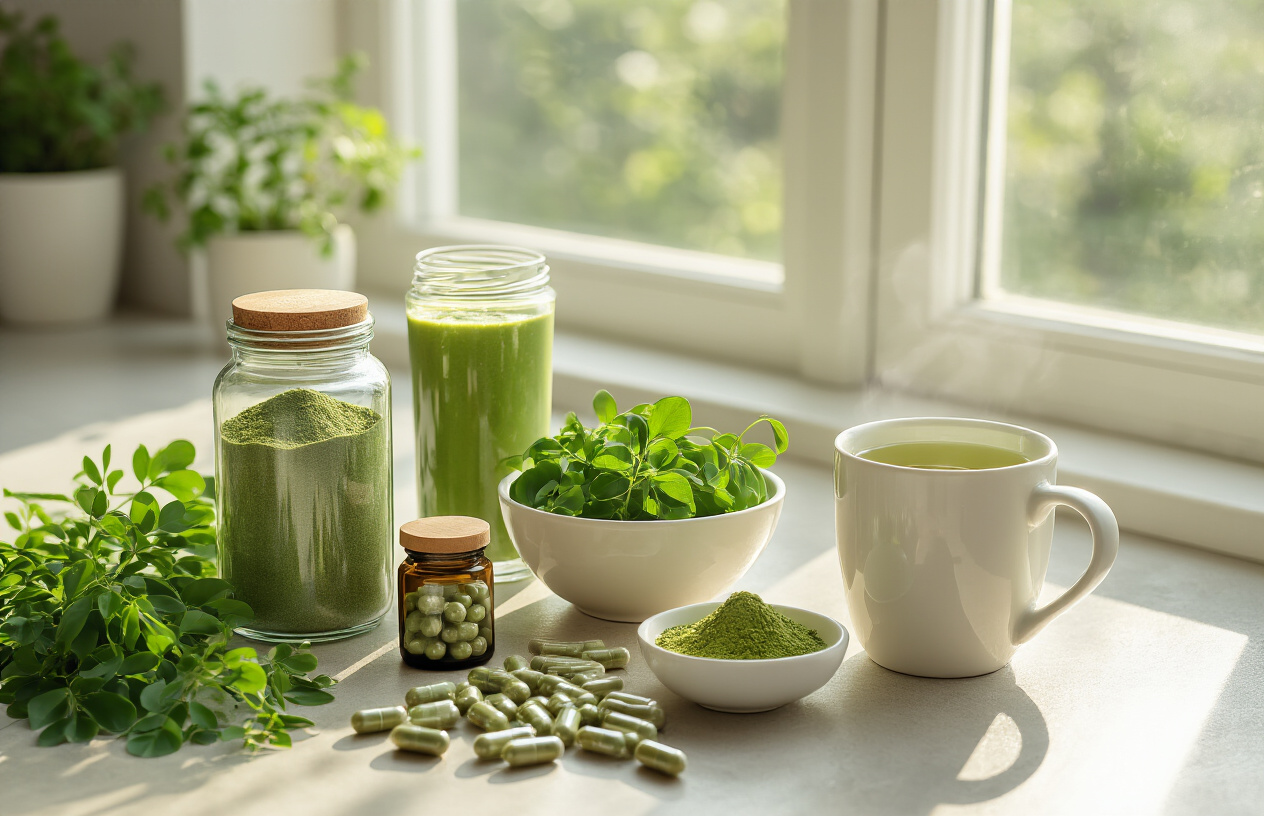
Morning Smoothie Recipes That Mask the Earthy Taste
You’ll find that smoothies are your best friend when learning how to use moringa daily, especially if you’re put off by its distinctive earthy flavor. The key is pairing moringa powder with ingredients that complement rather than fight its taste.
Start with a tropical blend that works every time: combine 1 teaspoon of moringa powder with frozen mango, pineapple, banana, coconut milk, and a squeeze of lime. The sweetness from the fruits completely masks any bitterness while the coconut adds creaminess that makes the texture irresistible.
For chocolate lovers, try mixing moringa with cacao powder, banana, almond butter, and your favorite plant milk. The rich chocolate flavor dominates while you still get all those moringa benefits for beginners. Add a handful of spinach if you want to double down on the green goodness without changing the taste.
Your morning routine becomes even easier with a green goddess smoothie: blend moringa powder with avocado, green apple, cucumber, lemon juice, and coconut water. The apple provides natural sweetness while the avocado creates that smooth, milkshake-like consistency.
Pro tips for smoothie success:
- Always add moringa powder last and blend for only 30 seconds to preserve nutrients
- Freeze your fruits ahead of time for thicker texture
- Start with ½ teaspoon moringa and gradually increase to 1-2 teaspoons
- Add honey or dates if you need extra sweetness while adjusting to the taste
Cooking with Moringa Powder in Everyday Meals
Your kitchen adventures with moringa powder open up countless possibilities beyond smoothies. This versatile superfood blends seamlessly into many dishes when you know the right techniques.
Soups and stews become nutritional powerhouses with just a teaspoon of moringa powder stirred in during the last few minutes of cooking. The earthy flavor actually complements hearty vegetable soups, lentil dishes, and chicken broths beautifully. You’ll barely notice the addition while boosting your meal’s vitamin content significantly.
Salad dressings transform into nutrient-dense superfoods when you whisk moringa powder into olive oil-based vinaigrettes. Mix it with lemon juice, olive oil, garlic, and herbs for a green goddess dressing that makes any salad more exciting.
Easy cooking integration methods:
| Dish Type | Amount | When to Add | Flavor Pairing |
|---|---|---|---|
| Soups | 1 tsp per serving | Last 2-3 minutes | Garlic, herbs, ginger |
| Pasta sauce | 1-2 tsp per cup | After removing from heat | Basil, oregano, parmesan |
| Rice dishes | 1 tsp per cup dry rice | During final fluffing | Coconut, curry spices |
| Scrambled eggs | ½ tsp per 2 eggs | Mixed with eggs before cooking | Cheese, herbs, peppers |
Baking with moringa powder works wonderfully in muffins, pancakes, and energy bars. Replace up to 2 tablespoons of flour with moringa powder in your favorite recipes. The slight color change creates beautiful green-tinted treats that taste amazing with vanilla, chocolate, or citrus flavors.
Creating Energizing Moringa Teas and Beverages
Your daily beverage routine gets a major upgrade when you discover the world of moringa teas and drinks. Unlike coffee’s caffeine crash, moringa provides steady, sustained energy that keeps you alert without the jitters.
Traditional moringa tea starts with steeping 1 teaspoon of moringa leaf powder in hot (not boiling) water for 3-5 minutes. The temperature matters – boiling water can destroy some of the delicate nutrients you’re after. Add honey, lemon, or ginger to create your perfect flavor profile.
Iced moringa beverages work perfectly for hot days or post-workout refreshment. Mix moringa powder into cold water with cucumber slices, mint leaves, and a splash of lime juice. This creates a spa-like drink that hydrates while delivering sustained energy.
Your moringa beverage arsenal:
- Golden Moringa Latte: Blend moringa with turmeric, ginger, cinnamon, and warm almond milk
- Citrus Moringa Water: Mix with lemon, orange slices, and sparkling water
- Herbal Moringa Blend: Combine with chamomile or peppermint tea for evening relaxation
- Green Energy Shot: Mix concentrated moringa powder with apple juice and ginger
Evening moringa teas can become part of your wind-down routine. Since moringa doesn’t contain caffeine, you can enjoy it any time of day. Try blending moringa powder with chamomile tea, honey, and a pinch of cinnamon for a soothing bedtime drink.
The beauty of these moringa beverages lies in their flexibility. You control the strength, flavor combinations, and timing to match your lifestyle perfectly. Start with smaller amounts and adjust based on your taste preferences and how your body responds to this incredible superfood.
Finding Quality Moringa Products That Deliver Results
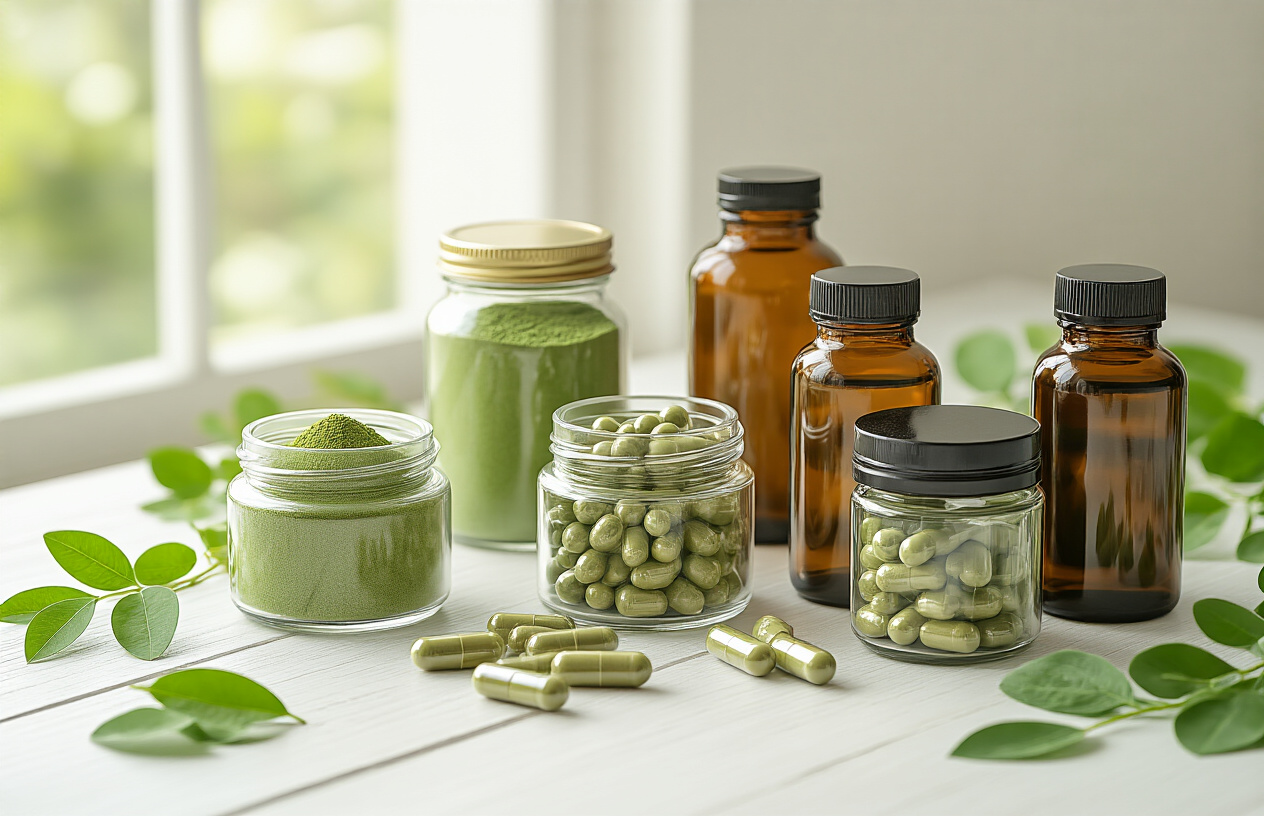
Key Quality Indicators to Look for When Shopping
Your success with moringa starts with choosing high-quality products. When shopping for moringa supplements, you’ll want to examine several critical factors that separate premium products from subpar ones.
Look for products that clearly display their origin. Best moringa supplements come from regions known for optimal growing conditions, particularly India, Africa, and Southeast Asia. The packaging should tell you exactly where your moringa was grown and processed.
Check the processing method. Moringa leaf powder benefits are maximized when leaves are shade-dried at low temperatures rather than exposed to high heat. This gentle processing preserves the delicate nutrients that make moringa so valuable. Quality manufacturers will proudly mention their low-temperature drying methods on their labels.
Third-party testing is non-negotiable. Reputable brands provide certificates of analysis showing their products have been tested for heavy metals, pesticides, and microbial contamination. You should be able to access these test results either on the packaging or the company’s website.
Color and texture matter too. Fresh, high-quality moringa powder should have a vibrant green color. If you notice brown or yellowish hues, the product may be old or poorly processed. The powder should feel fine and smooth, not gritty or coarse.
Trusted Brands and Where to Purchase Authentic Moringa
You have several reliable channels for purchasing authentic organic moringa products, each with distinct advantages.
Health food stores offer the benefit of seeing products firsthand and often employ knowledgeable staff who can answer your questions. Many carry established brands that have built reputations for quality and consistency.
Online retailers provide the widest selection and competitive pricing. Major e-commerce platforms feature customer reviews that give you real-world insights into product effectiveness. However, stick to sellers with high ratings and verified purchase reviews.
Direct-from-manufacturer purchases often provide the freshest products and best prices. Many moringa companies sell directly through their websites, offering subscription services that ensure you never run out of your daily supply.
Here are some purchasing tips by source:
| Source | Pros | Cons | Best For |
|---|---|---|---|
| Health stores | Expert advice, see product | Limited selection, higher prices | First-time buyers |
| Online retailers | Wide selection, reviews | Can’t examine product | Comparison shopping |
| Direct from manufacturer | Freshest products, bulk discounts | Limited to one brand | Regular users |
Price Ranges and Getting the Best Value for Your Money
Moringa pricing varies significantly based on quality, processing method, and packaging size. Understanding these price ranges helps you make informed decisions without overpaying or compromising on quality.
Budget-friendly options typically range from $15-25 for a one-month supply of powder or capsules. These products may work well for beginners testing their tolerance, but often lack the quality indicators mentioned above.
Mid-range products fall between $25-45 monthly. This category usually offers organic moringa products with proper certifications and third-party testing. You’ll find the best balance of quality and affordability here.
Premium products cost $45-75 per month but often justify the price through superior sourcing, advanced processing techniques, and comprehensive testing protocols.
Calculate cost per serving rather than focusing solely on package price. A $30 container with 60 servings costs $0.50 per serving, while a $20 container with 30 servings costs $0.67 per serving. The first option provides better value despite the higher upfront cost.
Bulk purchasing can significantly reduce your per-serving costs. Many manufacturers offer 10-15% discounts for three-month supplies and up to 20% savings for six-month purchases.
Organic vs Conventional: Making the Right Choice
The organic versus conventional decision impacts both your health outcomes and environmental footprint. Organic moringa products undergo stricter growing and processing standards that often translate to higher nutrient density and fewer contaminants.
Organic moringa farms avoid synthetic pesticides, herbicides, and fertilizers. Since moringa leaves concentrate nutrients from soil, organic growing methods ensure you’re getting beneficial compounds rather than chemical residues. This is particularly important given that you’ll likely consume moringa daily.
Conventional moringa costs 20-30% less than organic varieties, making it tempting for budget-conscious consumers. However, conventional farming may use chemicals that diminish some of moringa’s natural benefits.
The certification process for organic moringa involves regular third-party inspections, ensuring consistent quality standards. Look for USDA Organic, EU Organic, or equivalent certifications from the product’s country of origin.
Consider your personal priorities when making this choice. If you’re already eating organic foods and prioritizing chemical-free nutrition, organic moringa aligns with your existing health philosophy. If budget constraints are your primary concern, conventional moringa still provides significant nutritional benefits.
For most beginners exploring moringa benefits for beginners, starting with a mid-range organic product offers the best introduction to this superfood’s potential while ensuring product safety and quality.
Safe Usage Guidelines and Potential Side Effects to Know
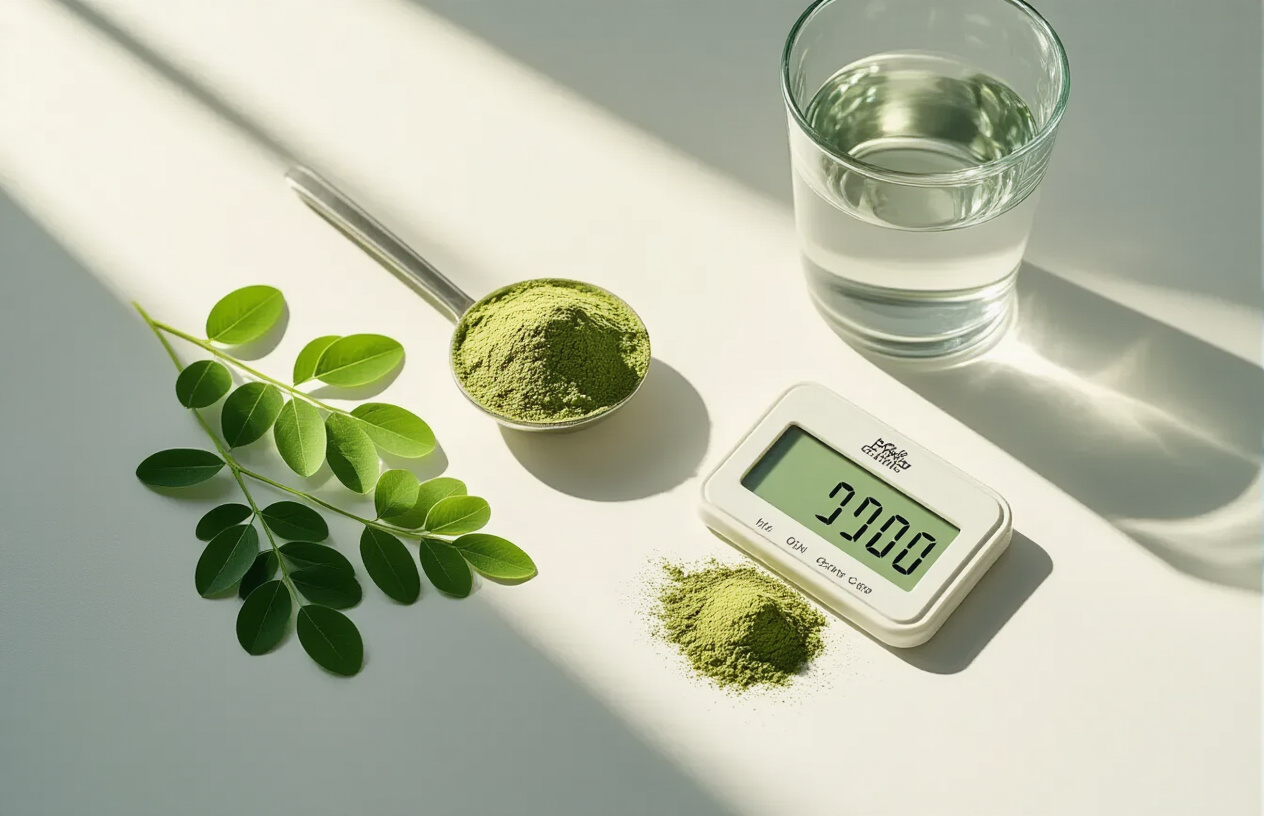
Recommended Daily Dosages for Beginners
Starting with moringa requires a gentle approach to avoid overwhelming your digestive system. Your body needs time to adjust to this nutrient-dense superfood, so begin with small amounts and gradually increase your intake.
For moringa powder, start with just 1/2 teaspoon (about 1-2 grams) daily during your first week. You can mix this into smoothies, yogurt, or sprinkle it over salads. After your body adjusts, slowly work up to 1-2 teaspoons daily, which provides optimal moringa benefits for beginners without causing digestive upset.
If you prefer moringa capsules, begin with one 500mg capsule daily with food. Most people can safely increase to 2-3 capsules daily after two weeks. Always take capsules with meals to enhance absorption and reduce stomach irritation.
Fresh moringa leaves offer another option – start with 20-30 leaves daily, either eaten fresh or brewed into tea. You can increase this to 50-70 leaves once your body adapts.
Never exceed 10 grams of moringa daily, as higher amounts may cause unwanted side effects. Keep a simple journal tracking your dosage and how you feel to find your sweet spot.
Who Should Avoid Moringa or Use Caution
Certain groups need extra care when considering moringa supplements or should avoid them entirely. Pregnant women should completely avoid moringa, especially the bark, roots, and flowers, as they may trigger uterine contractions and potentially cause miscarriage.
Breastfeeding mothers should consult their healthcare provider before using moringa, even though some cultures traditionally use moringa leaves during lactation. The safety data remains limited for nursing mothers.
People with autoimmune conditions like rheumatoid arthritis, multiple sclerosis, or lupus should exercise caution. Moringa can stimulate immune system activity, potentially worsening autoimmune symptoms.
If you have diabetes, monitor your blood sugar closely when starting moringa. This superfood can lower blood glucose levels, which might cause hypoglycemia when combined with diabetes medications.
Those with low blood pressure should start very slowly, as moringa may further reduce blood pressure. People scheduled for surgery should stop taking moringa at least two weeks beforehand due to its blood sugar effects.
Children under 12 should only use moringa under medical supervision, and always choose organic moringa products to avoid pesticide exposure.
Possible Interactions with Medications and Supplements
Moringa can interact with several common medications, making it essential to understand these relationships before adding it to your routine. The most significant concern involves blood sugar medications like metformin, insulin, or sulfonylureas. Moringa naturally lowers blood glucose, so combining it with diabetes drugs may cause dangerously low blood sugar levels.
Blood pressure medications present another area of caution. If you take ACE inhibitors, beta-blockers, or calcium channel blockers, moringa’s blood pressure-lowering effects might amplify your medication’s impact, leading to hypotension.
Blood-thinning medications like warfarin, aspirin, or clopidogrel may interact with moringa’s natural anticoagulant properties. This combination could increase bleeding risk, especially important if you’re scheduled for dental work or surgery.
Thyroid medications require special attention since moringa may interfere with thyroid hormone absorption or function. Space moringa consumption at least four hours away from thyroid medications.
Iron supplements and moringa work well together, as moringa enhances iron absorption. However, if you’re taking medications for iron overload conditions, discuss moringa use with your doctor first.
Always inform your healthcare provider about your moringa use, especially before starting new medications or adjusting existing prescriptions.
Recognizing and Managing Minor Side Effects
Most people tolerate moringa well, but knowing potential side effects helps you use it safely. Digestive issues represent the most common moringa side effects, especially when you start with too high a dosage or take it on an empty stomach.
Mild stomach upset, nausea, or loose stools typically occur during your first few days of use. Combat these by taking moringa with food, reducing your dose temporarily, and drinking plenty of water throughout the day.
Some people experience a metallic taste when using moringa powder. This usually indicates you’re taking too much too quickly. Scale back your dosage and try mixing moringa into strongly flavored foods like smoothies with berries or chocolate.
Headaches occasionally occur as your body detoxifies. Stay well-hydrated and consider taking moringa earlier in the day rather than evening. If headaches persist beyond a week, reduce your dosage or pause use temporarily.
Sleep disturbances affect some users due to moringa’s energizing properties. Take your daily dose before 2 PM to avoid interference with nighttime sleep.
Skin reactions like mild rash or itching are rare but possible. Stop using moringa immediately if you develop any skin symptoms and consult a healthcare provider.
Most side effects resolve within 5-7 days as your body adjusts. If symptoms worsen or persist beyond two weeks, discontinue use and seek medical advice.
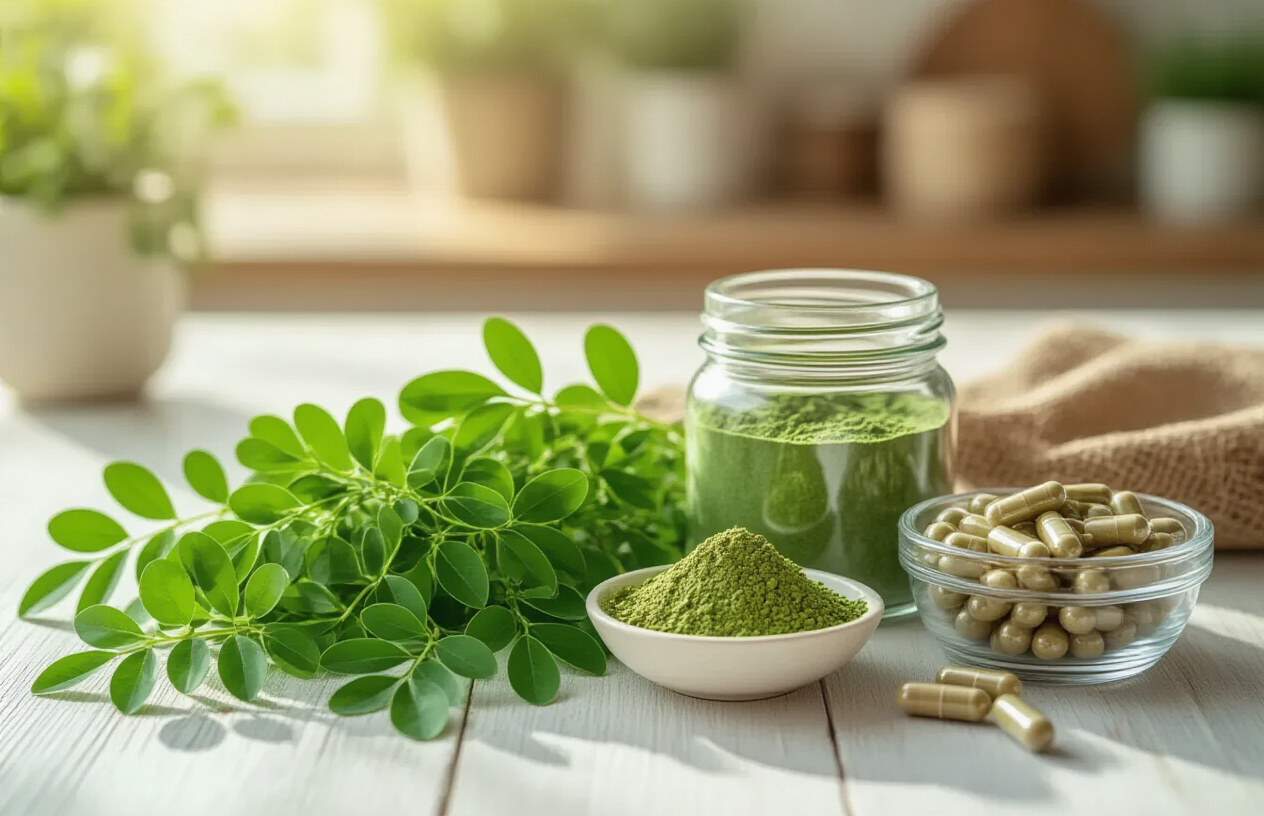
Moringa offers you a simple way to boost your nutrition with minimal effort. You’ve learned about its impressive nutrient profile, explored different forms from powder to capsules, and discovered easy ways to add it to your meals and drinks. You now know how to spot quality products and understand the safety guidelines that keep you on the right track.
Starting your moringa journey doesn’t have to be complicated. Begin with small amounts, choose one form that fits your lifestyle, and pay attention to how your body responds. Whether you blend the powder into smoothies or take convenient capsules, you’re taking a meaningful step toward better health. Remember to buy from trusted sources and consult your healthcare provider if you have any concerns. Your body will thank you for this nutrient-packed addition to your daily routine.
